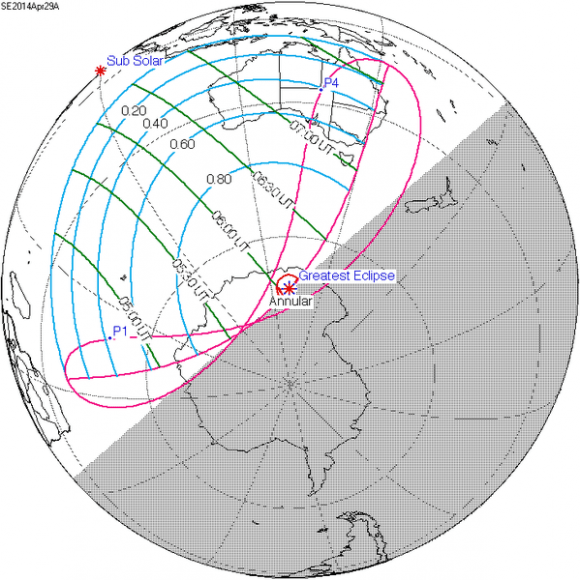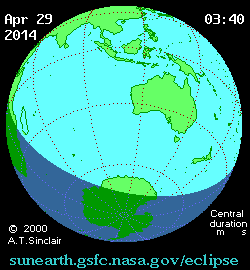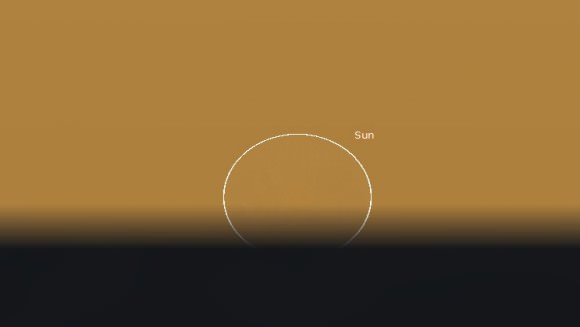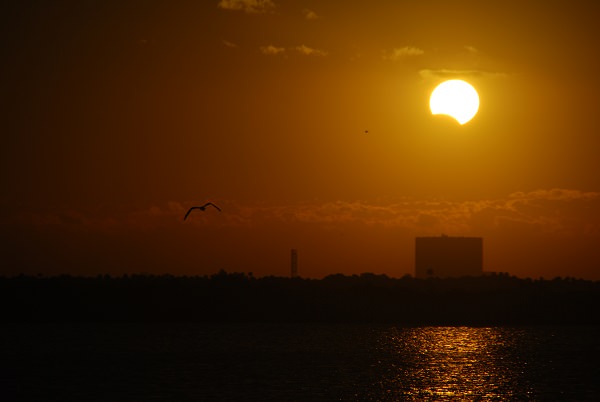Will anyone see next week’s solar eclipse? On April 29th, an annular solar eclipse occurs over a small D-shaped 500 kilometre wide region of Antarctica. This will be the second eclipse for 2014 — the first was the April 15th total lunar eclipse — and the first solar eclipse of the year, marking the end of the first eclipse season. 2014 has the minimum number of eclipses possible in one year, with four: two partial solars and two total lunars. This month’s solar eclipse is also a rarity in that it’s a non-central eclipse with one limit. That is, the center of the Moon’s shadow — known as the antumbra during an annular eclipse — will juuuust miss the Earth and instead pass scant kilometres above the Antarctic continent.

A solar eclipse is termed “non-central with one limit” when the center of the Moon’s umbra or antumbra just misses the Earth and grazes it on one edge. Jean Meeus and Fred Espenak note that out of 3,956 annular eclipses occurring from 2000 BCE to 3000 AD, only 68 (1.7%) are of the non-central variety. An annular eclipse occurs when the Moon is too distant to cover the disk of the Sun, resulting in a bright “annulus” or “ring-of-fire” eclipse. A fine example of just such an eclipse occurred over Australia last year on May 10th, 2013. An annular eclipse crossed the United States on May 10th, 1994 and will next be seen from the continental U.S. on October 14th 2023. But of course, we’ll see an end the “total solar eclipse drought” long before that, when a total solar eclipse crosses the U.S. on August 21st, 2017!

The “centrality” of a solar eclipse or how close a solar eclipse comes to crossing the central disk of the Earth is defined as its “gamma,” with 0 being a central eclipse, and 1 as the center of the Moon’s shadow passing 1 Earth radii away from central. All exclusively partial eclipses have a gamma greater than 1. The April 29th eclipse is also unique in that its gamma is very nearly 1.000… in fact, combing the 5,000 year catalog of eclipses reveals that no solar eclipse from a period of 2000 B.C. to 3000 A.D. comes closer to this value. The solar eclipses of October 3rd, 2043 and March 18th, 1950 are, however very similar in their geometry. Guy Ottewell notes in his 2014 Astronomical Calendar that the eclipses of August 29th, 1486 and January 8th, 2141 also come close to a gamma of 1.000. On the other end of the scale, the solar eclipse of July 11th 1991 had a gamma of nearly zero. This eclipse is part of saros series 148 and is member 21 of 75. This series began in 1653 and plays out until 2987 AD. This saros will also produce one more annular eclipse on May 9th 2032 before transitioning to a hybrid and then producing its first total solar eclipse on May 31st, 2068. But enough eclipse-geekery. Do not despair, as several southern Indian Ocean islands and all of Australia will still witness a fine partial solar eclipse from this event. Antarctica has the best circumstances as the Sun brushes the horizon, but again, the tiny sliver of “annularity” touches down over an uninhabited area between the Dumont d’Urville and Concordia stations currently occupied by France… and it just misses both! And remember, its astronomical fall headed towards winter “down under,” another strike against anyone witnessing it from the polar continent. A scattering of islands in the southern Indian Ocean will see a 55% eclipsed Sun. Circumstances for Australia are slightly better, with Perth seeing a 55% eclipsed Sun and Sydney seeing a 50% partial eclipse.

Darwin, Bali Indonesia and surrounding islands will see the Moon just nick the Sun and take a less than 20% “bite” out of it. Observers in Sydney and eastern Australia also take note: the eclipse occurs low to the horizon to the west at sunset, and will offer photographers the opportunity to grab the eclipse with foreground objects. Viewing a partial solar eclipse requires proper eye protection throughout all phases. The safest method to view a partial solar eclipse is via projection, and this can be done using a telescope (note that Schmidt-Cassegrain scopes are bad choice for this method, as they can heat up quickly!) or nothing more sophisticated than a spaghetti strainer to create hundreds of little “pinhole projectors.”

And although no human eyes may witness the annular portion of this eclipse, some orbiting automated ones just might. We ran some simulations using updated elements, and the European Space Agency’s Sun observing Proba-2 and the joint NASA/JAXA Hinode mission might just “thread the keyhole” and will witness a brief central eclipse for a few seconds on April 29th: And though there’ll be few webcasts of this remote eclipse, the ever-dependable Slooh is expected to carry the eclipse on April 29th. Planning an ad hoc broadcast of the eclipse? Let us know! As the eclipse draws near, we’ll be looking at the prospects for ISS transits and more. Follow us as @Astroguyz as we look at these and other possibilities and tell our usual “tales of the saros”. And although this event marks the end of eclipse season, its only one of two such spans for 2014… tune in this October, when North America will be treated to another total lunar eclipse on the 8th and a partial solar eclipse on the 23rd… more to come! Send in those eclipse pics to the Universe Today Flickr community… you just might find yourself featured in this space!


This is interesting stuff, I find the sequence of eclipses and the Saros cycles completely fascinating – and difficult to visualise. However there are a couple of points.
Apart from “1 Earth radii” (grrrr!), the sentence “A solar eclipse is termed “non-central with one limit” when the center of the Moon’s umbra or antumbra just misses the Earth and grazes it on one edge” seems a bit confusing. How can the center of the shadow, which is a one-dimensional line projected from the centre of the Sun through the centre of the Moon and on past or through the Earth, just miss the Earth but also graze it on one edge? Surely it must do only one or the other, and in this case it just grazes it to produce the very limited annular eclipse. Also, what does the “one limit” term signify?
And I’m sure I remember reading years ago that the minimum number of eclipses of any sort in a year could be 2, which had to be either both solar or both lunar. I’ll have to trawl through my old books to see if I can find a reference.
I remember going to France for the August 11th 1999 eclipse, which was the Saros precursor of the 2017 total mentioned above, thinking there would be more chance of clear skies than in the far SW of England which was the only bit of the UK it could be seen from. Unfortunately there was enough haze to hide totality from me while some non-astronomical friends who stayed here did manage to see it. Never mind! I hope to be able to get to the US for that one, there should at least be more chance of seeing it.
Thanks… referring to the antumbra as the center of the Moon’s shadow, the core of which just “nicks” the Earth on April 29th… though it can be argued that there’s a line central to that as well, that just misses touching down.
There is a minimum possible number of 4 eclipses (2 lunar+ 2 solar) in a calendar year, and a max of 7 if the season starts early enough.
http://en.wikipedia.org/wiki/Eclipse#Earth.E2.80.93Moon_System
The antumbra seems to be a cone shaped volume of the shadow signifying the places from which the eclipse would be annular, as opposed to the umbra from within which it is total, but I never came across the term before, which I probably should as I have a degree in Astronomy! If any part of the antumbra cone touched the Earth there would be an annular eclipse at those locations.
I found a reference in “Astronomy in Colour” (Peter Lancaster Brown 1972) saying that while the maximum eclipses in a year is 7, the minimum could be 2 solar and no lunar. In general there can be from 2 to 5 solar and from 0 to 3 lunar. I am looking for corroboration as I’m sure that I read this elsewhere too. I am wondering whether the other 2 could be penumbral lunar eclipses and hence not deemed ‘worthy’.
One other aspect of total solar eclipses is that they must start at sunrise and end at sunset somewhere on Earth. You can only imagine the panic if this happened at a place inhabited by some prehistoric tribe, expecting the Sun to appear in the morning but seeing a black disk, or even worse, watching it slowly disappearing during the late afternoon until it winked out of existence at sunset, not knowing whether or not it would reappear until next morning. What superstitions or rituals might have arisen because of this?
Interesting thoughts… there’s a great book entitled Many Skies that discusses the possible cultural impacts of an Earth with multiple moons, rings, bizarre eclipses, etc.
I talked to Michael Zeiler over at Eclipse-Maps about the minimum number of eclipses in a calendar year, and he references the discussion in Jean Meeus’ Mathematical Morsels Vol 1 pg 43 for the 4 eclipse per year minimum. Combing NASA’s 5 millennium eclipse catalog seems to bear this out, and Fred Espenak at the GSFC states a minimum of 2 per year for both solar and lunar eclipses.
Its true, the author of Astronomy in Colour may be disregarding shallow penumbral lunar eclipses: 2013 almost fit the bill for this, with 2 solars, 1 brief partial lunar and 2 penumbrals.
Thanks for the intelligent discussion, eclipses and their cycles are a fascinating topic.